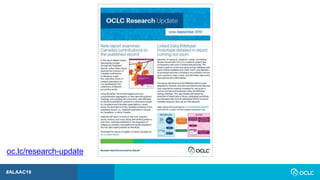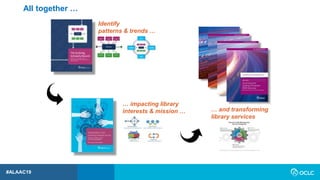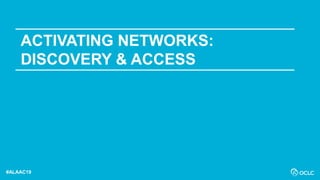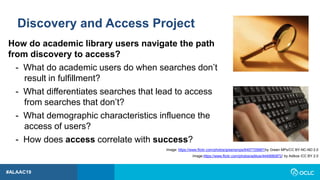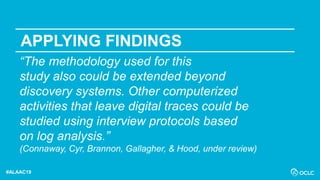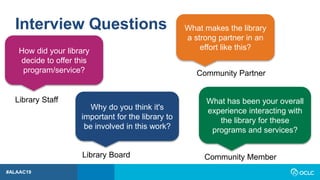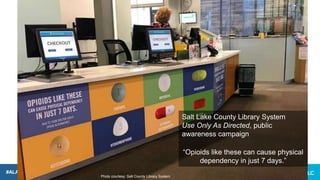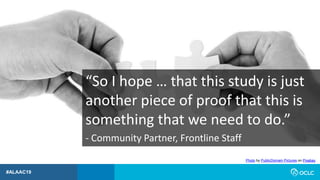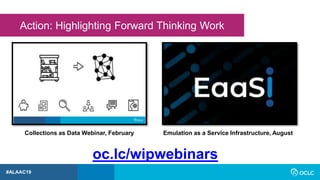OCLC Research update: Active engagement.
- 1. June 20–25, 2019 #ALAAC19 OCLC Research Update: Active Engagement Andrew K. Pace Executive Director Technical Research Lynn Silipigni Connaway, Ph.D. Director Library Trends and User Research Chela Scott Weber Senior Program Officer Research Library Partnership
- 2. Executive Director, Technical Research Andrew K. Pace
- 3. #ALAAC19 Membership and Research share one purpose: to accelerate and scale library learning, innovation, and collaboration.
- 4. #ALAAC19 As of 31 December 2018 A global network of libraries Americas 10,060 members in 23 countries EMEA 6,050 members in 78 countries Asia Pacific 1,472 members in 20 countries
- 5. #ALAAC19 18,000member libraries worldwide who elect 48delegates to Global Council, who elect 6members of the 15-member OCLC Board of Trustees
- 6. #ALAAC19 “research on our behalf” “I believe in the concept of the cooperative” “making the world feel smaller and connected for the public good” “power in numbers, power of the network, power of expertise” “understanding of shared challenges” “sharing and camaraderie” “innovation” “collaboration” Why OCLC?
- 7. #ALAAC19 OCLC Research Library Partnership OCLC’s Membership and Research Division • Research devoted exclusively to the challenges facing libraries and archives • Community resource for shared Research and Development • RLP is the platform to collaborate with institutions on research and issues • Lifelong learning from WebJunction
- 9. #ALAAC19
- 11. #ALAAC19 Project will: • investigate the viability of and approach to a Wikipedia + Libraries training program for library staff in Mexico • work with a partner based in Mexico to lead program • supports Wikimedia Foundation’s New Readers initiative Wikimedia Foundation Grant Expands Program to Mexico
- 12. #ALAAC19 • partnership with the National Network of Libraries of Medicine (NNLM) • customize the course to focus on how health and medical topics are accessed, used, and maintained on Wikipedia Customize Wikipedia Training for Health Topics • live, online course offered this fall to libraries of all types, in advance of an NNLM-hosted edit-a-thon • WebJunction will host a free preview webinar on this topic in August – see oc.lc/wikihealth
- 13. oc.lc/arc19
- 15. #ALAAC19 Identify patterns & trends … … and transforming library services All together … … impacting library interests & mission …
- 16. #ALAAC19 Activate collaborative networks that help libraries plan with confidence, position with effect, and make an impact.
- 18. #ALAAC19 FRAMING THE OPEN CONTENT DISCUSSION What has become entirely unambiguous, though, is that libraries are now expected—by researchers, funders, faculty colleagues, and especially end-users—to provide services that support open materials and workflows as fully as any other kind of content.
- 19. #ALAAC19 OCLC Global Council Program Committee Debbie Schachter Chair (ARC) Rupert Schaab (EMEA) Tuba Akbaytürk (EMEA) Kuang-hua Chen (APRC) Methodology • Not only OA – also other freely available online open content • Acknowledging the "continuum of openness“ • Global; all library types • Survey data collected November 12, 2018 – January 31, 2019 • Convenience sample of 705 respondents from 82 different countries
- 20. #ALAAC19 Overview of survey findings 705 responses from 82 different countries • 72% are Research and University libraries • 91% are currently involved in Open Content activities • Current top 3 Open Content activities: – Operating an institutional repository – Supporting users/instructors/digital literacy programs – Promoting the discovery of Open Content
- 21. #ALAAC19 • Where are you invested? • Where are you successful? • Is there identified funding for activities? • Where do you want to accelerate services? • What is the right scale (institutional, regional, national, global)? • Where do you see a role for OCLC? • Where is the work of OCLC Research likely to make an impact? We asked…
- 24. #ALAAC19 IDEATION-TO-PROTOTYPE IN 5 STEPS “Ideas are cheap.” Thomas B. Hickey, Ph.D. Chief Scientist, OCLC Research, 1977-2016
- 25. #ALAAC19 Step 1: Product vision statement Work with our members through a foundational shift in the collaborative work of libraries, communities of practice, and end-users— dramatically improving efficiency, embracing the inclusive, diverse, and earnest OCLC membership, and empowering a new and trusted knowledge work enabled by the web. Project Passage: Linked Data Wikibase Prototype
- 26. #ALAAC19 Step 2: Justification “Lean canvas” Succinct business- focused view that helps you determine the real effort behind a good idea
- 27. #ALAAC19 Quick-and-easy • This is a sniff-test, not a full business plan or market roll-out strategy • The more precisely right you try to be, the more precisely wrong you will be
- 28. #ALAAC19 Step 3: Put the band together “Happiness is best attained through fidelity to a worthy purpose.” - Helen Keller Photo by Austin Neill on Unsplash
- 29. #ALAAC19 Phase I Partners (Dec ’17 - Apr ‘18) – Cornell University – University of California, Davis “Project Passage” Phase II Partners (May ‘18 – Sept ‘18) – American University – Brigham Young University – Cleveland Public Library – Harvard University – Michigan State University – National Library of Medicine – North Carolina State University – Northwestern University – Princeton University – Smithsonian Library – Temple University – University of Minnesota – University of New Hampshire – Yale University OCLC Global Technolo- gies OCLC Research OCLC Global Product Management
- 30. #ALAAC19 Step 4: Set team expectations • Demand participation • Expect resistance • Communicate frequently • Document everything • Set an end-date for experimentation Photo by rawpixel on Unsplash
- 31. #ALAAC19 Step 5: Accept the outcome • Not every idea is a winner; fail fast and move on • You should be disappointed if you wind up with something that looks exactly like you expected to build from the start • If the plan for production looks different from your prototype, look back at your vision statement and lean canvas and see if they still hold true Photo by NeONBRAND on Unsplash Photo by Alvaro Reyes on Unsplash
- 32. #ALAAC19 BONUS STEP 6: MAKE IT REPEATABLE
- 33. Shaping an applied research agenda OCLC ResearchWorks • Engage the community—RLP Working Group • Convene a meeting—ResearchWorks • Develop a programmatic view of applied research at OCLC—Data Science & Machine Learning, Dataset creation, Applications, and APIs
- 34. #ALAAC19 ResearchWorks: Initiating an applied research agenda Charting a path for library community engagement with data science and a range of computational methods • enhanced demonstration of impact • expanded discoverability • progress on global information equity • actionable insights that support sustainability and the realization of core values ResearchWorks Working Group Led by Thomas Padilla, Practitioner Researcher-in-residence • Kenning Arlitsch, Montana State University • Jon Cawthorne, Wayne State University • Karen Estlund, Penn State University • Josh Hadro, IIIF Consortium • Bohyun Kim, University of Rhode Island • Trevor Owens, Library of Congress • Ben Schmidt, Northeastern University • Sarah Shreeves, University of Arizona • MacKenzie Smith, University of California Davis • Claire Stewart, University of Minnesota • Melissa Terras, University of Edinburgh • Diane Vizine-Goetz, OCLC Research • John Wilkin, University of Illinois at Urbana Champaign • Kate Zwaard, Library of Congress
- 35. Director, Library Trends & User Research Lynn Silipigni Connaway, Ph.D.
- 36. #ALAAC19 ACTIVATING NETWORKS: DISCOVERY & ACCESS
- 37. #ALAAC19 Discovery and Access Project How do academic library users navigate the path from discovery to access? - What do academic users do when searches don’t result in fulfillment? - What differentiates searches that lead to access from searches that don’t? - What demographic characteristics influence the access of users? - How does access correlate with success? Image:https://www.flickr.com/photos/adikos/4440680872/ by Adikos /CC BY 2.0 Image: https://www.flickr.com/photos/greensmps/6497729987/by Green MPs/CC BY-NC-ND 2.0
- 38. #ALAAC19 • Average of 5 minutes per session • Average of 2.2 searches per session • Average of 5.1 words per search • 12% of sessions had search refinements • 33% of sessions had multiple searches Summary of results for all academic institutions Image: https://www.flickr.com/photos/wwarby/3296379139/by William Warby/CC BY 2.0
- 39. #ALAAC19 Demographics of 14 interviewees Female, 9 Male, 4 Genderqueer, 1 Interviewees by Gender Undergrad, 9 Grad/post- grad student, 2 Faculty 2 Staff member 1 Interviewees by Academic Level Humanities, 5 Professional & Applied Sciences, 5 Social Sciences 2 Natural Sciences 1 Formal Sciences 1 Interviewees by Academic Discipline 19-25 years, 8 26-34 years, 4 35-44 years, 1 45-54 years, 1 Interviewees by Age
- 40. #ALAAC19 Critical Incident Technique (CIT) • Online surveys with CIT • Flanagan (1954) • Qualitative technique • Focuses on most memorable event/experience • Allows categories or themes to emerge rather than be imposed (Connaway, & Radford, 2018) Image: https://www.flickr.com/photos/306/319222005/ by *vlad* / CC BY-NC 2.0
- 41. #ALAAC19 APPLYING FINDINGS “The methodology used for this study also could be extended beyond discovery systems. Other computerized activities that leave digital traces could be studied using interview protocols based on log analysis.” (Connaway, Cyr, Brannon, Gallagher, & Hood, under review)
- 42. #ALAAC19 Search strategies • Interviewees refine their searches in various ways: • Identifiers • Limiters • Different/additional search terms • Topic refinement • Using a broad-to-narrow search strategy is prevalent • Interviewees search both Google/ Google Scholar and library databases • Titles are the most-used identifiers Image: https://www.flickr.com/photos/gotcredit/33627524011/ by GotCredit /CC BY 2.0
- 43. #ALAAC19 Conclusions for practice • Tandem use of log data and user interviews – Clarify qualitative data – Provide context for quantitative data – Most effective when digital traces are present – Inform development of literary instruction Image: https://www.flickr.com/photos/froderik/9355085596/ by Fredrik Rubensson / CC BY-SA 2.0
- 44. #ALAAC19 References Flanagan, J. C. “The critical incident technique.” Psychological Bulletin, 51(4), 327-358. 1954. Connaway, L. S., & Radford, M. L. (2018). Survey research. Webinar presented by ASIS&T, January 23, 2018. Retrieved from https://www.slideshare.net/LynnConnaway/survey-research-methods-with-lynn- silipigni-connaway and https://www.youtube.com/watch?v=4dlpAT7MXh0 Connaway L. S, Cyr, C., Brannon, B., Gallagher, P., & Hood, E. (Under Review). “Speaking on the record: Combining interviews with search log analysis in user research.” Under review for publication in the ALISE/ProQuest Methodology Paper Competition.
- 46. #ALAAC19 Public Libraries Respond to the Opioid Crisis with their Communities IMLS National Leadership Grant LG-00-18-0298-18
- 47. #ALAAC19
- 48. #ALAAC19
- 49. #ALAAC19 Project Activities Case study research Cross-sector discussions Call-to-action white paper Dissemination to the field
- 50. #ALAAC19 Case study sites • Everett, WA • Salt Lake, UT • New Orleans, LA • Peoria, IL • Kalamazoo, MI • Blount County, TN • Twinsburg, OH • Barrington, RI
- 51. #ALAAC19 Interview Questions Library Staff How did your library decide to offer this program/service? Why do you think it's important for the library to be involved in this work? What makes the library a strong partner in an effort like this? What has been your overall experience interacting with the library for these programs and services? Library Board Community Partner Community Member
- 52. #ALAAC19 Types of programs and services Naloxone training, staff and patrons Community reads and author talks Changes to physical layouts in bathrooms Peer navigators Deterra disposal bags Recovery Court Awareness and information campaigns Mental health and substance abuse related health programming
- 53. #ALAAC19 Salt Lake County Library System Use Only As Directed, public awareness campaign “Opioids like these can cause physical dependency in just 7 days.” Photo courtesy: Salt County Library System
- 54. #ALAAC19 Photo courtesy: Giles Clasen Denver Public Library, Community Resource Program Provides access to peer navigators to help community members by providing support and connecting them to public services
- 55. #ALAAC19 Photo by PublicDomain Pictures on Pixabay “So I hope … that this study is just another piece of proof that this is something that we need to do.” - Community Partner, Frontline Staff
- 56. Senior Program Officer, RLP Chela Scott Weber
- 57. #ALAAC19 ACTIVATING NETWORKS: ARCHIVES & SPECIAL COLLECTIONS
- 58. #ALAAC19 The Research Library Partnership is a program of the Research Division of OCLC It provides a unique transnational collaborative network of peers to address common issues And the opportunity to engage directly with OCLC Research
- 59. #ALAAC19 Archives, Special, and Distinctive Collections
- 60. #ALAAC19
- 62. Iterative, Participatory Process Advisory Board Discussions with Colleagues, April-May 2017 Workshop early draft at RBMS, June 2017 Workshop later stage draft at SAA, July 2017 Open Community Comment, August 2017
- 63. #ALAAC19 Areas of Investigation • Convergence of Special Collections and the Research Library • Advocating for Archives and Special Collections • Next Steps for Born Digital • Addressing Audiovisual Collections • Evolving Systems Environments • Stewardship Responsibility & Collection Management • Engaging the Challenge of Diversifying Collections
- 64. #ALAAC19 Areas of Investigation Convergence of Special Collections & the Research Library
- 65. Action: SHARES for Special Collections • Surveyed SHARES partners to learn about current practice. • Developing protocols and practices for sharing special collections among SHARES partners. • Building upon 2013 OCLC Research report Tiers for Fears, 2012 ACRL RBMS guidelines, and a recent Big Ten initiative on sharing special collections
- 66. #ALAAC19 Areas of Investigation Stewardship Responsibilities & Collections Management
- 67. #ALAAC19 Action: Building Knowledge Together Collection Building & Operational Impact Working Group
- 68. #ALAAC19 Areas of Investigation Addressing Audio-Visual Collections
- 69. Action: Assessing A/V Needs in the RLP Selection, Appraisal, Collection Development Incorporating into Archival Workflows Incorporating into Digital Collection Workflows Digitization & Preservation Reformatting Physical Collection Management Digital Asset Management & Preservation Resource Allocation, Assessment, & Prioritization What challenges related to managing A/V collections would you be interested in the RLP addressing?
- 70. #ALAAC19 Areas of Investigation Next Steps for Born-Digital
- 71. #ALAAC19 oc.lc/wipwebinars Action: Highlighting Forward Thinking Work Collections as Data Webinar, February Emulation as a Service Infrastructure, August
- 72. #ALAAC19 Areas of Investigation Advocating for Archives & Special Collections
- 73. Action: Data for Guidance and Advocacy 1998 - 2001 2009 - 2010
- 74. #ALAAC19 Get Involved • Attend upcoming webinars or watch a past offering oc.lc/wipwebinars • Read and use the Research & Learning Agenda, and let us know what you think oc.lc/rlp-agenda • Be in touch! weberc@oclc.org • Join the Primary Sources and RLP Announce email lists
- 76. #ALAAC19 Stay connected Andrew K. Pace pacea@oclc.org Lynn Silipigni Connaway, Ph.D. connawal@oclc.org Chela Scott Weber weberc@oclc.org
Editor's Notes
- OCLC libraries are part of an active and engaged global network of libraries with nearly 18,000 members across 121 countries. Global network provides unparalleled access to the world’s collected knowledge in ways that cannot be achieved independently Ability to address shared challenges at scale Together, we connect people to the information they need to achieve their goals [Notes current as of 5/2/19]
- The OCLC cooperative is member-governed. Its 18,000 member libraries worldwide elect 48 delegates to OCLC's Global Council, who in turn elect six members of the 15-member OCLC Board of Trustees. [Notes current as of 5/2/19]
- Libraries come together as OCLC to advance librarianship around the world – there is a commitment and a passion. Our cooperative is unique. Slide contains feedback from our Global Council members who were asked “why OCLC?” These quotes represent members’ appreciation for the uniqueness of the cooperative. [Notes current as of 5/2/19]
- OCLC's Membership and Research Division serves the OCLC global network of 16,000+ member libraries and beyond in several key ways: OCLC Research concentrates its efforts on research devoted exclusively to the challenges that libraries and archives face. The OCLC Research Library Partnership includes some 130 research library partners who collaborate with other libraries and each other on research and related issues through working groups. Since its launch in 2003, WebJunction has helped more than 80,000 library staff build the knowledge, skills, and confidence they need to deliver transformational services to their communities. WebJunction is free and welcome to all libraries to use, regardless of size, type, or location. [Notes added 8/27/18]
- OCLC Research continues to provide insight for the field in many areas. These are three of our most recent reports and all are available as free downloads on our website. Practices and Patterns in Research Information Management: Findings from a Global Survey. Jointly published with euroCRIS, the international organization for research information, this new report examines how research institutions worldwide are applying research information management (RIM) practices and the increasing role of libraries in supporting RIM activities. The report details the complexity of research information management practices. It examines how commercial and open-source platforms are becoming widely implemented across regions, coexisting with many region-specific solutions as well as locally developed systems. It also explores the factors that have led to the need for cross-stakeholder teams to support institutional RIM activities, which increasingly includes the library. University Futures, Library Futures. Published with Ithaka S+R, this new report identifies how changes in US higher education are shaping the future of academic libraries. The report presents a new framework for understanding today’s universities and explores how libraries are using services in nine key areas to adapt to evolving university priorities. Maple Leaves: Discovering Canada through the Published Record. By Brian Lavoie – continuation of work examining national presence in the published record. The Canadian contribution to literature, music, film, and other forms of creative expression is rich and deep. In this report, we explore the contours of this contribution, as it is manifested in the collections of libraries around the world. Using WorldCat, the world’s largest and most comprehensive aggregation of data describing global library holdings, and mapping the information with Wikidata to identify publications authored or otherwise created by Canadians and Canadian organizations, we trace the boundaries of the Canadian presence in the published record: i.e., materials published in Canada, by Canadians, or about Canada.
- Our learning program, WebJunction, builds the knowledge, skills and confidence library staff need to keep their libraries moving forward. How do we do that? WebJunction offers a catalog of more than 320 online courses and webinar recordings on new and emerging library services, programs and issues. Through the financial support of U.S. state library agencies and other partnerships, we are able to offer these courses for free to all library staff in any position, from directors to frontline, and at any time in their career. We continually seek out new insights and practices that libraries can learn from and apply in their own local communities. We write about current issues and gather practical resources for all to download and use. We also host free interactive webinars each month that allow library workers to tell their own library’s story of progress to hundreds of their peers from across the US and beyond. WebJunction also conducts multistate, national, and international projects to spread learning and bring library innovations to scale. Often these are in the form of online training programs that connect knowledge and skills to real-world library practice. These programs focus on important community issues such as employment, health and wellness, literacy, and the digital divide. [Notes current as of 5/2/19]
- Supercharged Storytimes for All. New, three-part, self-paced course now available along with lots of resources at oc.lc/supercharged. More than 2,000 people have already enrolled!
- WebJunction created the Wikipedia + Libraries: Better Together training program to help library staff leverage Wikipedia to better serve their communities. Now, with a newly awarded Project Grant from the Wikimedia Foundation, OCLC will work to expand the project to Mexico. OCLC will investigate the viability of and approach to a Wikipedia + Libraries training program for library staff in Mexico, in support of the Wikimedia Foundation’s New Readers initiative.
- The National Network of Libraries of Medicine (NNLM) has contracted OCLC to customize WebJunction’s Wikipedia + Libraries: Better Together training course to focus on how health and medical topics are accessed, used, and maintained on Wikipedia. The live, online course will be offered this fall to libraries of all types, in advance of an NNLM-hosted edit-a-thon. WebJunction will adapt the curriculum and lead the training, with support of subject matter experts from NNLM.
- Mark your calendars for the 2019 Americas Regional Council Conference, which will be held in early October in Phoenix, Arizona. Conference agenda highlights include: 16 breakout sessions featuring thought leaders from across the library community Thought-provoking keynote and featured speakers Opportunities to network with fellow library leaders and OCLC staff Wednesday dinner event at the internationally recognized Heard Museum, featuring American Indian art Can especially emphasize: Two preconference workshops for academic, research, and public libraries Registration is open at oc.lc/arc19. [Notes current as of 5/2/19]
- Here is a visualization of how some of our research reports – and the models and frameworks developed in the reports – tie together into an integrated view of how our work has addressed an important topic like the evolving scholarly record. First, our research helped us document and visualize some general patterns and trends associated with a scholarly record that is evolving to incorporate a broader range of research outputs and new configurations of the stakeholder eco-system. Next, we unpacked these trends in terms of their impact on a key aspect of the library mission: libraries’ traditional role as stewards of the scholarly record. We explored how stewardship models were likely to evolve in the context of a scholarly record that was itself evolving in the ways we described in our first report. We then drilled down into a specific aspect of the evolving scholarly record - research data management - and developed a high-level view of the RDM service space, and then looked at how four different research universities developed RDM services within that space. Along the way we produced a set of models that helped visualize and socialize our ideas and findings, by circumscribing the topic of interest, enumerating key components and relationships, and providing a vocabulary for discussing the topic both inside and outside the library community. So this example illustrates the ways we approach our work in OCLC Research: we try to understand emerging trends in the information environment (like our Evolving Scholarly Record report); we examine how these trends impact critical aspects of the library mission (like our report on stewardship of the scholarly record); and we think about the implications for transforming library services (like our series of reports on RDM).
- 18
- Global Members Council in relation to the Open Content survey. Indeed, the survey was their initiative. Last year, they expressed interest in exploring the impact and use of open access in libraries. ---------- The scope is intentionally expansive and includes all open content that is relevant to the large diversity of libraries. We define is as the full range of freely available, unrestricted, online content (including OA-scientific articles and e-books, pre-prints, open educational resources, governmental and non-governmental publications, grey literature, open datasets, open collections from digitized heritage, web-resources like YouTube videos, news websites, any freely available born-digital materials, etc.). The online survey was circulated as widely as possible, through the networks of the Global Council Delegates, through the OCLC Research Library Partnership and other, relevant networks, and through social media. Responses came in between 12 November 2018 and 31 January 2019. Within such a short timeframe, we received a record number of 705 responses from 82 different countries. The pool of respondents was self-selected and not representative from a methodological point of view. The responses should be considered as individual voices instead of statistics. However, for analysis purposes, we have tried to group responses together in order to be able to distill some meaningful data.
- 20
- These are the open content activities that University & Research Libraries currently support. As you can see, the institutional repository scores highest of all OC activities reported by this group of libraries.
- Image: https://www.flickr.com/photos/greensmps/6497729987/ by Green MPs / CC BY-NC-ND 2.0 Image: https://www.flickr.com/photos/adikos/4440680872/ by Adikos / CC BY 2.0
- Image: https://www.flickr.com/photos/wwarby/3296379139/by William Warby/CC BY 2.0
- Flanagan, J. C. “The critical incident technique.” Psychological Bulletin, 51(4), 327-358. 1954. Connaway, L. S., & Radford, M. L. (2018). Survey research. Webinar presented by ASIS&T, January 23, 2018. Retrieved from https://www.slideshare.net/LynnConnaway/survey-research-methods-with-lynn-silipigni-connaway and https://www.youtube.com/watch?v=4dlpAT7MXh0 Image: https://www.flickr.com/photos/306/319222005/ by *vlad* / CC BY-NC 2.0
- Connaway L. S, Cyr, C., Brannon, B., Gallagher, P., & Hood, E. (Under Review). “Speaking on the record: Combining interviews with search log analysis in user research.” Under review for publication in the ALISE/ProQuest Methodology Paper Competition.
- Image: https://www.flickr.com/photos/gotcredit/33627524011/ by GotCredit /CC BY 2.0
- Image: https://www.flickr.com/photos/froderik/9355085596/ by Fredrik Rubensson / CC BY-SA 2.0
- OCLC and PLA developed a research and programming proposal, which was funded by an IMLS National Leadership Grant this past summer. The title of the project is “Libraries Respond to the Opioid Crisis with their Communities” and it runs through the end of 2019. This project combines the expertise and capacity of OCLC’s Research division, the free and open learning platform of OCLC’s WebJunction platform, the advocacy and policy capacities of PLA, and the reach and network of both organizations.
- I wanted to share a little bit of what brought us to this project and this work. In fall of 2017 we partnered on a WebJunction-hosted virtual townhall in September 2017 . This even included invited speakers from libraries and community partners who had stories and resources to share, This wordcloud includes the topics surfaced in the chat space during the town hall--things like training, staff, and community, as well as some of the synthetic opioids and overdose reversal medications.
- And of course, there is the information in the media, and these are just a few headlines that have surfaced over the years. High-profile stories like these, as well as ongoing concerns and questions raised by library staff, leaders, boards, and support organizations, led OCLC and PLA to join forces to learn more about the issue and how our organizations might help libraries navigate the crisis.
- This grant-funded project consists of four main deliverables, listed here. Today, we’ll focus on the case study research, we will start disseminating next month.
- This first deliverable is a series of eight case studies profiling how libraries are responding to the opioid crisis along with partners in the community. This map represents the sites that were studied. These locations range in size from around 16,000 people to over 800,000. They also represent a range of different resources, different library infrastructures, and different communities. You’ll note that there is a cluster of states on the map, including Illinois, Michigan, Ohio and Tennessee – and this is in part because these areas have been heavily hit by the crisis. The fact that these examples represent a range of community interventions is also important – the case studies represent a variety of partnerships that come with different strengths and capacity. Our goal was to show that this can take many different forms and can be helpful to libraries in communities with different needs and there isn’t a single way to do this – you can create your own path. In addition to these eight states, we also worked with the Denver Public Library to pre-test the interview protocol and also write a profile about their experience and response for the community.
- To create these case studies, we conducted interviews on site at each of the locations. The locations were bucketed into four different groups of interviewees: library staff, library board members, staff at the community partner organizations and community members/patrons. With most interviews, we had no more than 14 main questions, plus some prompts to dig in a little deeper if there was an opportunity. Most of the interviews with library and community partner staff lasted around 45 minutes. Interviews with community members were closer to 15 minutes. Here are examples of the questions that we asked.
- Through our research, a range of programming and services were surfaced. There are high-touch responses that involved trained staff and a detailed partnership – such as peer navigator programs, which connect patrons in need to information and ideas about services available in the community. Often these peer navigators come with “lived experience”, and have dealt with their own addictions or overdoses. There are lower-touch examples such as providing medication disposal bags to patrons which can be used to safely dispose of unused or unwanted prescription medications so that they can’t be abused. There were examples of activities and programming that can fit all kinds of communities and budgets. For example, hosting an community reads event where everyone reads the same book and then the library hosts a discussion is something that many libraries can do, and it doesn’t require a major investment, and it is well-aligned with other programming that the library already offers. There is no one-size or prescription for how to handle this. Each library has a different community and different needs, so what fits one, will not necessarily work in others. OCLA and PLA are coming away from this research effort understanding that it is important to let libraries and their communities determine what is best for them locally, and we can focus on providing the information, resources, and capacity to help those libraries make well-informed decisions.
- Salt Lake County Utah has a large display right at the checkout desk of the public library, to help community members recognize what an opioid looks like and increase awareness about their potential hazards. This display sparks conversation with patrons, as well as in families. Staff noted that children have asked about the “candy” in the pictures. Which is a good reminder to parents that children often don’t realize a pill is a potentially dangerous medication. This same library also has a large display (see next slide)
- LYNN One of the most impactful programs that we learned about is the Denver Public Library’s Community Resource Program, which you will hear more about from Michelle and Marion. This was originally designed to help with patrons who were experiencing homelessness, and as the opioid epidemic became more prevalent, the library shifted to also work with patrons on opioid-related issues. A powerful aspect of the Denver program is that it includes the use of peer navigators. These peer navigators are staff members who have what is called “lived experience.” They may have formerly experienced homelessness, or addiction themselves, and now they have an opportunity to work helping others. They are able to use their experiences to connect to people and provide access to services that the library and their partners offer. These peer navigators go out and meet people and introduce themselves and look for opportunities to provide some support. Some days this could be with giving them access to a phone to make a call, or it may be connecting them to a local shelter or housing assistance. And sometimes, they are literally just someone to talk to. With compassion and patience.
- One of the interviewees shared this with the research staff. And it really speaks to the importance of both the research and what is happening around the country with this crisis. In addition to the case studies that will be published next month, we’ll also be sharing the results of this work with organizations outside of public libraries, to encourage them to see libraries as partners in effort to address the opioid epidemic. Based on the research and the cross-sector discussions, we’ll create a call-to-action white paper to help more libraries and more organizations to find the opportunity to work together and help to address this crisis.
- Hi, I’m so pleased to be here today to represent the Research Library Partnership. As Andrew explained, the RLP is one part of the larger Membership and Research Division. And we are a unique, international collective of peer institutions and colleagues, and together with my fellow program officers, we work hard to create opportunities and spaces for members of the partnership to work together to address common issues facing research libraries. Today I’m going to talk a little bit about our work specifically in archives and special collections.
- OCLC Research has a long history of work in the area of archives, special, and distinctive collections in research libraries. We work in special collections because they are an important sight of knowledge creation, and because that work in archives is made possible by library’s significant commitment to the stewardship of their distinctive collections. The unique nature of material in special collections can make scaling a challenge, and we work to identify areas of common need and patterns of innovation to help libraries scale learning and expertise with these collections.
- In 2009, OCLC Research undertook a detailed survey of over 275 archives and special collections in research and academic libraries. That work, and the and resulting paper by Jackie Dooley, Taking Our Pulse, helped to shape the work OCLC Research and the RLP did for years to come – including a broad range of work centering on how to make special collections more accessible, and a series on demystifying working with born-digital collections.
- In October 2017, we released the Research & Learning Agenda for Archives, Special, and Distinctive Collections. The agenda was, in many ways, a follow up to Taking Our Pulse, we wanted to pause and reflect on what still held true from that work, what issues had largely been addressed, and what new challenges and opportunities had emerged– so that in order to help us think about where we should be placing time and effort of OCLC Research with regard to archives, special, and distinctive collections.
- The way we created the agenda was situated as being a community look, leveraging our expertise but represents not just our work and concerns but those of many other stakeholders. We recognize that some of these areas are not well suited to OCLC work, and that other stakeholders would be strongest to lead on certain issues. With this community-wide intention, the agenda was created via a quite participatory and iterative process. I consulted regularly with an advisory group of AULs and Heads of Special Collections, had focused conversations with colleagues across all levels of experience and areas of expertise conducted invited workshops for early stage drafts of the agenda at SAA and RBMS conferences. A final draft was circulated and posted as a google doc along with an open call for comments for that many colleagues took advantage of. The result is a document that discerns and articulates the shared challenges and opportunities research libraries are are facing in this sphere, and suggests approaches for working on them together. The agenda will guide OCLC Research work in this area in the future, and we hope it will also serve to frame larger conversations and spur action across the field.
- The agenda called out seven major areas for investigation: Convergence of Special Collections and the Research Library Advocating for Archives and Special Collections Next Steps for Born Digital Addressing Audiovisual Collections Evolving Systems Environments Stewardship Responsibility and Collection Management Engaging the Challenge of Diversifying Collections Today I’m going to highlight a few of these, and talk about the ways we are activating the network in service of special collections
- Stewardship Responsibilities and Collection Management Addressing backlogs of hidden collections has been a major focus of time and energy across the profession in the last two decades. The agenda recognizes that while important work and progress have been made, backlogs of un and under-described and inaccessible collections continue to plague archives and special collections. It also discusses backlogs as an issue not just because they impede access, but because they also impede our ability to make responsible and programmatic decisions about collection management, collection development, and resource allocation broadly, as well as impede efforts to advocate for special collections. Suggested research activities in this area outline a variety of strategies to continue to chip away at backlogs – appraisal, building modern and extensible processing programs, re-conceptualizing accessioning, and generally looking more closely at backlogs to better understand the nature of the problem in order to better address it.
- To address needs around advocacy, appraisal, and collection stewardship responsibilities, we have assembled a Collection Building and Operational Impact working group. The group is investigating how special collections repositories are approaching maintaining a balance between collection stewardship and collection building. They are working to develop a lifecycle framework for thinking about the full range of resources necessary to responsibly acquire and steward archives, special, and rare book collections, and the impact that collection acquisitions have on operational capacities, and will be developing a cost estimation tools as well as a suite of sample documentation to facilitate better communication amongst peers, decision-making for collection building, and advocacy for the necessary resources for their ongoing stewardship of those collections.
- Addressing Audio-Visual Collections A/V holdings continue to be a top concern in archival repositories, both because of evolving modes of scholarship in which these are increasingly valuable and sought-after sources, and because of preservation concern that many a/v formats are at or near end of life. The volume of A/V holdings is staggering, and exceeds the ability to do preservation reformatting in many institutions. Additionally, legacy poor practice in collections management for these formats means that many a/v collections are not well enough managed or understood to make informed decisions about their care. We’re working now to better understand needs in this area, beyond our initial conversations in the creation of the agenda.
- We did a survey in March Holding conversations in May Will be looking at the landscape of work in this area and talking to allied orgs so as not to duplicate work Still figuring out where we are best suited to work to address this need. Welcome feedback from IRLA members.
- Next Steps for Born-Digital Our 2009 survey indicated that born-digital was an emerging area of need. The agenda recognizes that born-digital collections and programs have grown exponentially in the decade since, and the needs we found in this area reflect growth from pilot to program phases. Much early work in this area focused on capture of data from physical media, and the work necessary at the earliest stages of stewarding digital collections to ensure authenticity and preservation. Next steps must address the full array of activities that come after capture, including access, appraisal, and arrangement and description. Similarly, many nascent electronic records programs focused on advocating for a digital archivist position. This area identifies a need from moving beyond creating a digital archivist position to building distributed models of responsibility for born-digital archival programs, as well as finding cohorts across the research library where complimentary work is happening. Suggested research activities in this area address both the programmatic and structural challenges facing our born-digital programs.
- Webinars One of the key ways we highlight the work of others is through our Works in Progress webinar series. There is lots of good work going on in born-digital realm via DLF, SAA ERS, and other communities. We want to highlight that work rather than duplicate it. Collections as Data – pushing how we conceive of access to collections and what it means to steward them Emulation as a Service – again pushing on how we might give access to
- Advocating for Archives and Special Collections Running through the agenda is a discussion of re-conceptualizing the value of archives and special collections in the research library, and this area of investigation centers around what might be needed to increase our capacity to communicate that value and advocate for the resources to support our programs. While there has been much lip service to the value of special collections in distinguishing the research library, that hasn’t consistently translated to resources for special collections. The agenda recognizes that the heavy reliance on soft monies in special collections can mask ongoing need, and soft monies are often used for both ongoing operational need and to launch new new projects. It also recognizes the importance of making data-backed arguments about need and impacts. Suggested research activities in this area address developing skills in advocacy, building data sets to back up that advocacy, and understanding the true landscape of resource allocation to special collections.
- If you are interested in keeping appraised of our work in this area, there are a number of ways for you to get involved. Attend upcoming webinars responding to issues outlined in the Research & Learning Agenda. You can also watch a recording of any of the webinars I mentioned previously. If you haven’t already, read the Research & Learning Agenda. Colleagues at other institutions have been using it as a conversation and strategic planning tool, and we’re eager to hear your feedback on what within the agenda is most relevant to your program. Be in touch! I would be happy to hear from you. As your program officers, we’re always available to be a resource to you and can help you think through a challenge or point you to resources and projects we’re aware of across the Partnership, and really, this is the most fun part of our job so we’re happy to be a resource to you if we can. If you work for an RLP institution, please join the Primary Sources email list, where we post opportunities and events specifically related to our work on archives and special collections. You can email me and I can sign you up.














